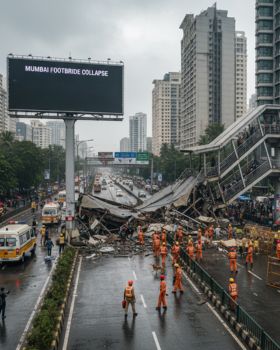
Disclaimer:
This blog is intended for informational purposes only and should not be construed as legal, health, or safety advice. While every effort has been made to ensure the accuracy of the information provided, SHEQ Network and its affiliates accept no responsibility for any loss or damage resulting from reliance on the content. Organizations are encouraged to consult with their legal, compliance, or safety professionals to ensure they meet all applicable laws and industry regulations. References to past incidents are based on publicly available information and are used to illustrate the importance of contractor safety and compliance. Mention of the mai™ Contractor Portal is for promotional purposes and should not be interpreted as a guarantee of accident prevention or regulatory compliance.
In 2019, a contractor tragically lost his life after falling from scaffolding on a construction site in the UK. Investigations revealed a disturbing pattern of preventable errors—no proper site induction, unverified working-at-height training, and outdated safety documentation from the subcontractor. These oversights highlight a common challenge in industries that rely on contractors: when there is no clear system in place to manage and verify compliance, lives can be put at risk.
While no software can completely eliminate accidents, many risks could be significantly reduced with a well-structured contractor management system in place. Systems like these serve as a safeguard, helping organizations ensure that only qualified and properly trained individuals access their worksites.
The Risks of Unstructured Contractor Oversight
In many businesses, contractor details are scattered across spreadsheets, email threads, and paper files. There’s no guarantee that insurance details are up-to-date or that all safety documents have been reviewed. As projects scale and multiple vendors get involved, this fragmented approach becomes even more difficult to manage.
For subcontractors—often several steps removed from the principal contractor—the situation can be even murkier. Without centralized oversight, subcontractor documentation often goes unchecked, and compliance becomes a guessing game. This is where a reliable contractor management portal adds real value—by offering transparency and a single source of truth for all contractor-related records.
Moving Beyond Paper and Email
Traditional methods—though familiar—are prone to delays and human error. For example, relying on email to collect induction records or training certificates often leads to missing or outdated files. Spreadsheets can’t automatically flag expired licenses or missed deadlines. And paper-based risk assessments can easily be lost or ignored.
A structured digital platform doesn’t replace human responsibility—it enhances it. By using a centralized contractor portal, businesses can simplify how they collect, store, and review critical documentation.
How Smart Contractor Systems Add Value
A modern contractor management solution doesn’t need to be overly complex to be effective. The best systems focus on what matters most:
Centralized contractor profiles – Store licenses, insurance details, safety documents, and training records in one place.
Induction and training validation – Ensure contractors and subcontractors meet the required standards before arriving onsite.
Document expiry alerts – Get notified before insurance or certification lapses.
Pre-qualification workflows – Use digital forms to screen vendors before approval.
Audit readiness – Maintain organized records that are easily retrievable when needed.
By focusing on simplicity, structure, and visibility, these platforms support safety and operational efficiency without micromanaging each task or worker.
Learning from the 2019 Case: What Could Help
Let’s revisit the 2019 incident. While no software could physically prevent a fall, a well-configured contractor management system could help in several ways:
Identify missing or expired working-at-height certifications before work begins.
Flag outdated safety documentation submitted by subcontractors.
Ensure the worker had completed the required induction before site access.
The goal isn’t to automate everything—it’s to give safety managers and project leads the tools they need to make better decisions and act before issues escalate.
Understanding the Role of Subcontractor Oversight
Subcontractors are an essential part of many projects, yet they often fall outside the direct oversight of the main contractor. This gap can become a serious liability, especially when subcontractors bring in their own teams with unknown compliance levels.
A well-integrated subcontractor management software feature allows organizations to extend visibility and document requirements to secondary vendors. Rather than chasing down paperwork manually, companies can request and verify key documents from all parties involved—without adding administrative burden.
Aligning Safety with Accountability
Every contractor on-site represents your brand’s safety culture. Without clear visibility, gaps in compliance can erode even the most well-meaning policies. A centralized contractor portal helps enforce consistent onboarding processes, track documentation status, and minimize the risk of missed steps.
Importantly, these tools are not about surveillance or complexity—they’re about accountability. When teams know what’s required and systems support them in meeting those requirements, safety becomes embedded in the process, not an afterthought.
✅ Conclusion: Promote Safety, Minimize Risk with the mai™ Contractor Portal
The tragic loss of life in the 2019 incident underscores the importance of structured contractor oversight. While no digital tool can remove all risk, the mai™ Contractor Portal is designed to help organizations better manage contractor data, verify compliance, and make proactive decisions that enhance worksite safety.
As a complete contractor management solution, the mai™ Contractor Portal simplifies how businesses handle insurance documents, licenses, training records, and risk assessments. With powerful features like pre-qualification workflows, RAMS tracking, vendor rating, and alert notifications, this contractor management portal supports safe, streamlined contractor engagement.
Whether you’re managing direct vendors or multiple tiers of subcontractors, the mai™ platform functions as a reliable contractor management system with built-in subcontractor management software capabilities. It’s a smarter, more organized way to promote safety, protect your business, and ensure compliance—without making things more complicated.
🔗 Learn more at sheqnetwork.com and transform the way you manage contractor safety today.
👉 Ready to see it in action? Book your free demo here!
Ready to transform? Contact us today at info@sheqnetwork.com or call us at +353 21 4536034 for a personalized demo!



